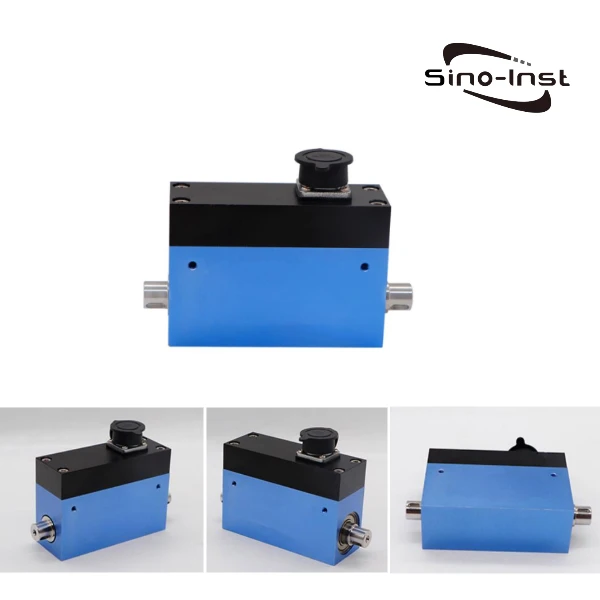
1050D Dynamic Torque Sensor for Dynamic Micro Torque is an integrated product composed of resistance strain sensitive components and integrated circuits. It is made of alloy steel/stainless steel material. The structural design has a small size range and high precision. The output terminal of positive and negative torque signals is the key link. The instantaneous speed can reach 4000 rpm. It is widely used in all kinds of small-scale torque measurement such as micro-motors, viscometer rotating power equipment systems, etc.
Features of 1050D Dynamic Torque Sensor
- Based on the principle of resistance strain type, power supply and signal output are realized through brushes.
- Various small-scale torque measurements. It can measure the torque value in both forward and reverse directions.
- Both ends are connected by shaft keys, which is easy to install and use.
- The maximum speed does not exceed 4000 rpm.
Technical Parameters
| Parameters | Specifications |
| Range | 0-10,20,30,50,100,200,500,1000Nm |
| Sensitivity | 1.5±10% mV / V |
| Zero output | ±2% F.S. |
| Nonlinear | ±0.1,0.3% F.S. |
| hysteresis | ≤±0.05% F.S. |
| Repeatability | ≤±0.05% F.S |
| Creep | ≤±0.03% F.S/30min |
| Temperature Sensitivity Drift | 0.03% F.S. / 10℃ |
| Zero temperature drift | 0.03% F.S. / 10℃ |
| Input resistance | 750±10Ω |
| Input resistance | 700±5Ω |
| Insulation resistance | ≥5000MΩ/ 100VDC |
| Excitation voltage | 10-15VDC |
| Temperature Compensation Range | -10 ~ 60ºC |
| Range of working temperature | -20 ~ 80ºC |
| Safe overload | 150% F.S. |
| Extreme overload | 200% F.S. |
| Cable size | Ø5.2×3m |
| Electrical connections | Red/E+, Black/E-, Green/S+, White/S- |
| Material | Stainless or Alloy Steel |
Dimensions
Frequently asked questions
If you cannot find an answer to your question in our FAQ, you can always contact us
and we will be with you shortly.
More Featured Torque Sensors
Sino-Inst is a manufacturer of 1050D Dynamic Torque Sensor for Dynamic Micro Torque Measurement-5Nm. We offer more than 10 types of Dynamic Torque Sensors. Dynamic Torque Sensors can measure a variety of different mechanical power, rotational speed and torque measuring devices.
Dynamic Torque Sensors are widely used in the following areas:
Application in process industry and process industry;
In sewage treatment systems, measure the relevant power and torque;
Measure the power and torque of machinery such as aircraft, ships, railway locomotives and mines;
Can be used to make viscometers;
Measuring the output power and torque of related devices such as internal combustion engines and rotational forces;
Measure power and torque of torque wrenches, water pumps, etc.
Dynamic Torque Sensor is also called rotary torque transducer, torque transducer. Mainly used for torque measurement in dynamic situations. The dynamic torque sensor is equipped with a speed measuring device, which can measure the rotational speed while measuring the torque. At this time, the torque sensor can also be called a torque speed sensor.
Sino-Inst’s Dynamic Torque Sensor, made in China, have good quality, with better prices. Our Dynamic Torque Sensors are widely used in China, India, Pakistan, USA and other countries.
Sino-Inst’s entire team is well trained, so we can ensure that each customer’s needs are met. If you need any help with your product requirements, whether it is a Dynamic Torque Sensor, level sensors, or other equipment, please give us a call .
Request a Quote
Wu Peng, born in 1980, is a highly respected and accomplished male engineer with extensive experience in the field of automation. With over 20 years of industry experience, Wu has made significant contributions to both academia and engineering projects.
Throughout his career, Wu Peng has participated in numerous national and international engineering projects. Some of his most notable projects include the development of an intelligent control system for oil refineries, the design of a cutting-edge distributed control system for petrochemical plants, and the optimization of control algorithms for natural gas pipelines.
1050D Dynamic Torque Sensor for Micro Torque-0.1,0.5,1-5Nm
1050D Dynamic Torque Sensor for Dynamic Micro Torque is an integrated product composed of resistance strain sensitive components and integrated circuits. It is made of alloy steel/stainless steel material. The structural design has a small size range and high precision. The output terminal of positive and negative torque signals is the key link. The instantaneous speed can reach 4000 rpm. It is widely used in all kinds of small-scale torque measurement such as micro-motors, viscometer rotating power equipment systems, etc.
Product SKU: 1050D Dynamic Torque Sensor for Dynamic Micro Torque Measurement
Product Brand: Sino-Inst
Price Valid Until: 2029-09-09
Product In-Stock: InStock
5